If you would prefer to download this document
as a pdf file, Click Here.
LIST
OF TABLES AND CHARTS
Interest Rates
Expected to Ease
World Growth
to Moderate
Canadian
Dollar Expected to Rise
Oil Prices
to Moderate
Natural Gas
Prices to Moderate
Agricultural
Prices Firming
Canadian Inflation
Edging Up
Economic Activity
in Alberta Remains Strong
Investment
Strengthens
Rig Activity
Remains Strong
Gas Sales
Expand with Pipeline Capacity
Non-Conventional
Oil Production Growing
Major
Exports Strong
Declining
Unemployment Rate
Job Growth
Continues
People Still
Moving to Alberta
Earnings
Growth in Alberta
Disposable
Income Showing Robust Growth
Housing Strong
Retail Sales
Recovering
Diversification
Strengthens Alberta
Key Energy
and Economic Assumptions
Sensitivities
to Fiscal Year Assumptions, 2001-02
Alberta Real
Gross Domestic Product Forecast Benchmark
Oil Price
Forecast Benchmark
Natural Gas
Price Forecast Benchmark
Canadian
Short-Term Interest Rate Forecast Benchmark
Canadian
Long-Term Interest Rate Forecast Benchmark
Canada/United
States Exchange Rate Forecast Benchmark
Tracking
the Forecasts of Oil Prices
Tracking
the Forecasts of Alberta Real GDP
Announced
Major Projects Over $100 Million
ECONOMIC
OUTLOOK
A strong rebound in energy sector
investment helped the economy grow by an impressive 6.1% in 2000, the fastest
growth among provinces. Continued strong economic growth of 4.8% is expected
in 2001, led by robust consumer spending and rising exports.
Although energy prices are
expected to decline to more sustainable levels, Alberta’s economy should
continue expanding at a healthy 3.2% per year, on average, over the medium
term. Personal and corporate tax cuts will keep consumer and business
confidence high, while exports are expected to rise as major manufacturing and
oil sands investment projects begin production.
2000 IN REVIEW
Rebound in energy sector leads
growth
-
World oil prices increased
from an average of U.S.$19.30 per barrel in 1999 to an average of
U.S.$30.29 per barrel in 2000.
-
High demand and tight U.S.
natural gas supplies boosted natural gas prices to record levels. Between
January and December 2000, the Alberta reference price rose well over 200%
to $8.73 per thousand cubic feet (mcf). The Alberta reference price
averaged $4.50 per mcf in 2000, up from $2.48 per mcf in 1999.
-
As a result, investment in the
energy sector is estimated to have risen by $4.9 billion, or 47%, to $15.4
billion last year. The average number of rigs drilling in 2000 increased
to 295, up 41% from 209 in 1999, while the total number of oil and gas
wells drilled increased by 3,987, or 61%, to 10,512 in 2000.
-
The rebound in energy
investment was a key factor driving Alberta’s real GDP growth, estimated
at 6.1% in 2000. The sharp rise in energy prices also raised nominal GDP
an estimated 22%.
Non-energy sector also healthy
-
Despite some regional
problems, net farm income was up 12.6% in 2000. A 4.3% decline in crop
cash receipts was offset by a 11.5% increase in livestock receipts as the
cattle sector remained healthy and hog prices recovered.
-
Building permits increased by
10% in Alberta for 2000.
-
The value of manufacturing
shipments was up 17.3% in 2000, led by increases in petroleum and coal
products (62%), machinery (27%), primary metals (22%), paper and allied
products (19%), and fabricated metals (19%).
Good job prospects and tax cuts
strengthen household spending
-
The unemployment rate averaged
5.0% in 2000, down from 5.7% in 1999. By December 2000, Alberta’s
unemployment rate was 4.8%, the lowest among the provinces.
-
Employment increased by 34,900
jobs or 2.2% in 2000, led by increases in trade (11,200), construction
(11,000), accommodation and food services (10,600), professional,
scientific and technical services (5,900), transportation and warehousing
(5,900) and manufacturing (5,800). Skill shortages may be emerging in some
sectors.
-
The strength of the Alberta
economy attracted a net total of 21,951 interprovincial migrants in 2000,
up from 13,985 in 1999.
-
In 2000, wage settlements in
Alberta averaged 4.3%. Strong growth in labour income, the elimination of
the provincial surtax, provincial tax rebates, and federal income tax cuts
contributed to a 7.1% rise in disposable income.
-
These income gains helped
increase consumer purchasing power despite the rise in inflation to 3.5%.
As a result, retail sales in Alberta rose 8.9% in 2000 and total housing
starts rose 3.2%.
GLOBAL ECONOMIC OUTLOOK
United States and the global
economy are slowing down
-
Growth slowed sharply in the
United States in the second half of 2000, as the economy responded to the
rise in interest rates the year before. The extent and suddenness of the
slowdown caught many analysts by surprise.
-
The U.S. Federal Reserve has
reacted strongly to the continued weakness in the U.S. economy, cutting
interest rates by 1 percentage point in January 2001, and by another half
percentage point in late March. Although Alberta Finance expects the
Federal Reserve to successfully avoid an outright recession, U.S. growth
is expected to slow to around 2% this year, down from 5% in 2000. Economic
growth is also expected to moderate in the rest of the world.
-
The unexpectedly sharp
slowdown in the United States has led the Bank of Canada to cut Canadian
interest rates by three-quarters of a percentage point since January.
Lower interest rates and major federal and provincial tax cuts are
expected to keep consumer spending reasonably healthy this year. However,
economic growth in Canada is expected to slow from 4.7% in 2000 to around
2.9% in 2001, as exports to the United States slow.
Commodity prices ease
-
With slower global demand
growth, world oil prices are expected to head down from US$30.20 per
barrel in the 2000-01 fiscal year to US$25 in 2001-02, and US$21
thereafter.
-
With oil prices declining and
increased natural-gas-directed drilling in Canada and the United States,
natural gas prices are also expected to fall back from their recent record
peaks to average $6.07 per mcf in 2000-01, $5.03 in 2001-02, $3.75 in
2002-03, and $3.44 in 2003-04.
-
In contrast, agricultural
prices are expected to firm somewhat. Grain prices appear to have bottomed
out, hog prices have recovered from recent lows and cattle prices are
expected to remain healthy.
-
Consumer price inflation in
Alberta is expected to fall to 2% this year from 3.5% last year.
Provincial energy rebates reduced the CPI index for natural gas in Alberta
by close to 40% between December 2000 and February 2001, and moderated the
increase in the CPI index for electricity to around 5%. CPI inflation
rates are expected to decline as the recent run-up in energy prices is
unwound. This will increase consumer purchasing power.
ALBERTA ECONOMIC OUTLOOK
Tax cuts keep economic growth at
4.8% in 2001
-
Alberta’s new personal
income tax system, originally announced in Budget ’99, became fully
effective on January 1, 2001. Increased personal and spousal exemptions
and the introduction of a 10% single rate tax will result in estimated
annual savings for Alberta taxpayers of $1.1 billion in 2001, bringing the
total tax cut to $1.5 billion, a 23% reduction since 1998.
-
The federal government has
followed Alberta’s lead in indexing the personal tax system to
inflation. It has also cut personal tax rates and eliminated its high
income surtax.
-
Continued strong employment
and wage growth and the large provincial and federal tax cuts are expected
to increase the amount of money in consumers’ pockets and raise living
standards. Personal disposable income is expected to increase by about 10%
in 2001. As a result, real consumer spending is expected to grow 6.3% in
2001.
-
Real exports are expected to
rise 5.8% this year, as petrochemical and oil sands expansions come into
production.
-
Energy sector investment will
remain strong due to natural gas directed drilling and major oil sands
projects. Non-energy investment activity is expected to decline somewhat
this year as construction ends and production begins at several major
projects. Overall, real private investment in 2001 is expected to be about
the same as last year.
-
As a result of tax cuts,
increased consumer spending and healthy exports, Alberta’s real GDP is
expected to grow by 4.8% this year.

LISTS
OF TABLES AND CHARTS
SLOW
US GROWTH SPILLS OVER INTO CANADA
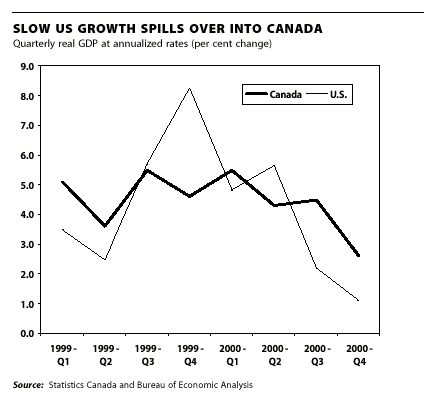
-
U.S. growth slowed sharply from 5.6% at annual
rates in the second quarter of 2000 to 1.0% in the fourth. The extent and
suddenness of the slowdown caught analysts by surprise. A number of analysts
are concerned that the current contraction in the manufacturing sector will
become widespread and lead the entire economy into recession.
-
The slowdown in the United States is spilling
over into Canada. Canadian growth fell from 4.5% in the third quarter last
year to 2.6% in the fourth quarter. Canadian employment has risen by only
6,900 since last December.

INTEREST
RATES EXPECTED TO EASe

-
With inflation remaining relatively subdued,
the U.S. Federal Reserve has reacted strongly to the emerging weakness in
the U.S. economy. The Fed cut interest rates by 1 percentage point in
January, and by an additional half percentage point in March.
-
The Bank of Canada has also cut interests
rates, although not as aggressively as in the United States. The Bank cut
rates by one-quarter percentage point in late January and another half
percentage point in early March, citing the unexpectedly sharp slowdown in
U.S. activity.
-
The Bank is not expected to fully match U.S.
interest rate cuts this year, as low unemployment and large federal and
provincial tax cuts are expected to maintain healthy growth in consumer
spending.

WORLD
GROWTH TO MODERATE

-
Given the sharp reduction in interest rates
and the likelihood of substantial tax cuts later this year, the U.S. economy
is expected to strengthen in the second half of 2001. Overall economic
growth is expected to be about 2% this year in the United States, down from
a sizzling 5% in 2000.
-
Slower growth in the United States is expected
to dampen growth in the rest of the global economy, particularly in Canada.
Growth in Canada is expected to slow from 4.7% in 2000 to 2.9% this year.
Lower interest rates and tax cuts should help sustain consumer spending,
even though exports are expected to slow.

CANADIAN
DOLLAR EXPECTED TO RISE
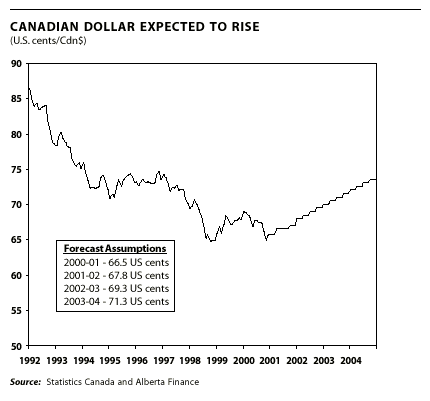
-
The Canadian dollar has weakened sharply
against its U.S. counterpart this year, in common with most other
currencies.
-
The fundamentals -- low inflation, good
economic prospects, a large current account surplus, and a relatively strong
fiscal position -- suggest that the Canadian dollar should gradually
appreciate over the medium term.

OIL
PRICES TO MODERATE
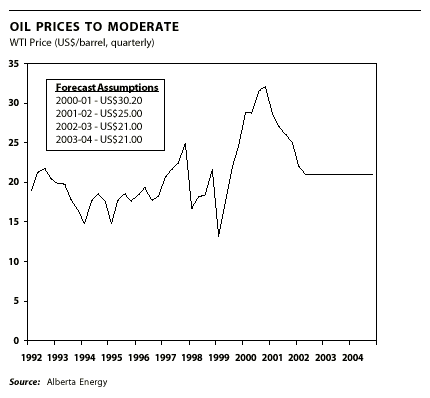
-
Strong global economic growth and tight OPEC
supply discipline boosted oil prices in 1999 and 2000. Oil prices averaged
US$30.20 per barrel in 2000-01, up from US$23.16 per barrel in 1999-2000.
-
Prices have eased from their November peaks of
around US$35/bbl to around US$27 per barrel in March. In March, OPEC
announced substantial production cuts in order to prevent a sharp decline in
prices.
-
Oil prices are expected to average US$25 per
barrel in fiscal 2001-02 and US$21 per barrel thereafter.

NATURAL
GAS PRICES TO MODERATE

-
Low natural gas inventory levels and high
demand for electricity generation resulted in huge increases in natural gas
prices in the United States in 2000. By January 2001, the Alberta Reference
Price had reached $11.82/mcf.
-
In Alberta, increased pipeline capacity has
allowed domestic gas prices to follow the U.S. lead. AECO-C spot prices have
increased over 100% since last March to around $7 per mcf.
-
The Alberta reference price is expected to
average $6.07 for 2000-01, up from $2.66 in 1999-2000.
-
In the medium term, natural gas prices are
expected to fall back as natural gas supplies rebound and demand growth
eases.

AGRICULTURE
PRICES FIRMING

-
Livestock prices generally improved in 2000
due to the recovery in hog prices and continued strength in cattle prices.
Livestock prices were up 12% in 2000. Livestock cash receipts remained
strong in Alberta, increasing 11.5%, led by hog cash receipts (up 45.6%) and
calves (up 25.6%).
-
Prices for crops showed some signs of firming.
Prices for wheat fell 9.7% in 1999, and remained virtually flat in 2000.
Wheat futures prices in February 2001 were 8% higher than in February 2000.
Even though crop receipts for barley were up 14.4% in 2000, a 13.3% decline
in canola receipts and a 6.2% decline in wheat receipts resulted in a 4.3%
decline in crop cash receipts for Alberta producers in 2000.

CANADIAN
INFLATION EDGING UP
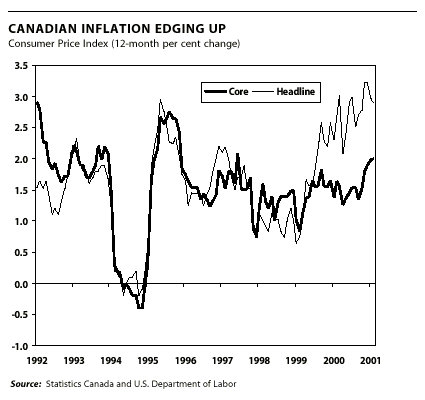
-
In Canada and around the world, higher energy
prices have pushed up the overall Consumer Price Index (CPI) inflation rate.
The overall CPI inflation rate was 2.9% in Canada in February.
-
The core CPI inflation rate, which excludes
food and energy, is a indication of underlying inflation pressures. After
remaining stable at around 1.5% for the past 3 years, it edged up to 2% in
February. This is still in the middle of the Bank of Canada's 1% to 3%
inflation target zone.
-
Domestic cost pressures remain subdued in
Canada. The economy has become less energy-intensive since the 1970s, but
more importantly, the rise in energy prices is expected to be temporary and
thus has not had a strong impact on inflation expectations.

ECONOMIC
ACTIVITY IN ALBERTA REMAINS STRONG
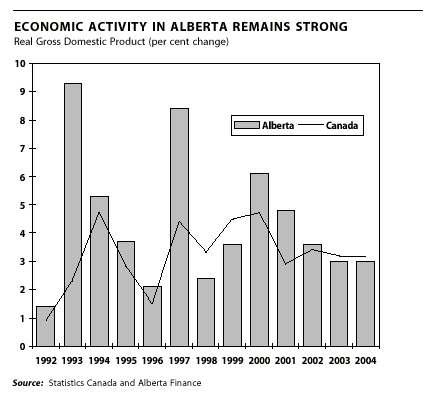
-
Alberta has grown faster than Canada in 8 of
the past 10 years.
-
In 2000, Alberta's economy grew an estimated
6.1% due to a rebound in energy sector investment. Growth this year is
expected to be 4.8%, the fastest in Canada.
-
Although energy prices are expected to fall
back to more sustainable levels in the medium term, Alberta's diversified
economy is expected to expand at a healthy 3.2% as tax cuts boost consumer
and business spending, and major projects in manufacturing and oil sands
come on stream, increasing exports.

INVESTMENT
STRENGTHENS

-
The rebound in the energy investment dominated
Alberta’s economic performance in 2000. Conventional oil and gas
investment (exploration and development drilling), combined with continued
strong oil sands investment, raised real energy investment an estimated 50%
in 2000.
-
Real energy investment is expected to increase
further, by almost 8% this year as investment in oil sands peaks, and
natural gas directed drilling remains strong.
-
After modest growth of about 1.3% in 2000,
real non-energy investment is expected to fall by about 10% this year as
major projects are completed. Corporate income tax cuts should help boost
growth in the medium term.
-
Non-energy investment expected in the near
future includes major projects in utilities ($3.5 billion), transportation
infrastructure ($3.9 billion), pipelines ($3 billion), and commercial
and real estate developments ($2.8 billion).

RIG
ACTIVITY REMAINS STRONG
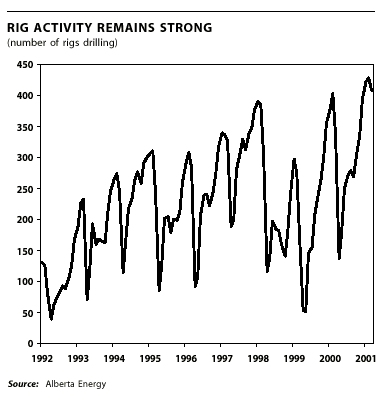
-
Rig activity remained strong in 2000, due to
high energy prices. The number of rigs drilling increased 41.1% compared to
1999.
-
In the first quarter of 2001, the average
number of rigs drilling was 12.5% higher than during the same period last
year.
-
The total number of oil and gas wells drilled
in Alberta rose 61% in 2000 to 10,512. Gas wells accounted for 69% of the
total.

GAS
SALES EXPAND WITH PIPELINE CAPACITY
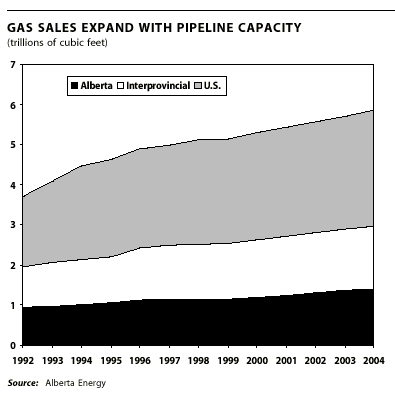
-
Conventional crude production has been
declining since 1995, and is expected to continue to decline.
Non-conventional crude production, on the other hand, has been increasing
sharply, and is expected to boost energy exports as new projects come on
stream.
-
Non-conventional oil production is forecast to
rise over 90% from current levels by 2004. It is expected to account for
over 60% of Alberta's oil production in 2004, compared to an estimated 43%
in 1999.
-
Over $16 billion worth of investment projects
have been announced for the next 10 years. An additional $25 billion worth
of projects are in the proposal stage.

non-conventional
oil production growing
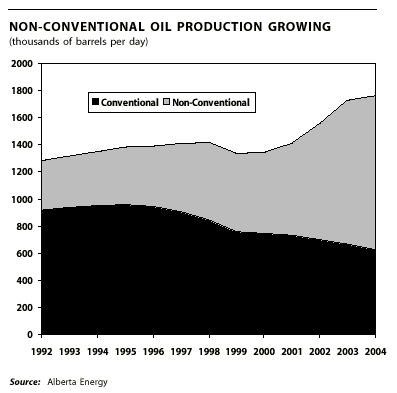
-
Conventional crude production has been
declining since 1995, and is expected to continue to decline.
Non-conventional crude production, on the other hand, has been increasing
sharply, and is expected to boost energy exports as new projects come on
stream.
-
Non-conventional oil production is forecast to
rise over 90% from current levels by 2004. It is expected to account for
over 60% of Alberta's oil production in 2004, compared to an estimated 43%
in 1999.
-
Over $16 billion worth of investment projects
have been announced for the next 10 years. An additional $25 billion worth
of projects are in the proposal stage.

major
exports strong

-
In 2000, Alberta’s international goods
exports were up 59.9%, the highest rate of growth in the country. Machinery
and equipment was up 80.6%, and energy products 85.3%.
-
Total exports of goods and services, including
those to the rest of Canada, are estimated to have risen by 32.1% in 2000 to
about $81 billion, led by a $15.6 billion surge in the value of oil and
natural gas exports. Exports accounted for 58% of the Alberta economy in
2000.
-
The value of Alberta’s exports is expected
to increase again this year due to the rising value of natural gas exports
and higher manufacturing exports as several major petrochemical plants come
on stream.

declining
unemployment rate

-
Strong economic growth reduced Alberta’s
unemployment rate from 5.7% in 1999 to an average of 5.0% in 2000.
-
In March 2001, the unemployment rate was 4.8%,
the lowest among provinces.
-
Alberta’s unemployment rate is expected to
decline gradually over the forecast horizon to around 3.5% by 2004. This is
low by historical standards.

job
growth continues

-
Employment growth in 2000 was a healthy 2.2%
or 34,900 jobs. Gains were led by trade, construction and accommodation and
food services.
-
Shortages of skilled labour may have been a
factor constraining employment growth in some industries.
-
This year, the Alberta economy is expected to
create 39,000 new jobs.
-
Over the medium term, employment in Alberta is
expected to grow at an average rate of 2.3% per year.
-
Approximately 153,000 more jobs are forecast
to be created from 2000 to 2004.

people
still moving to alberta

-
After dropping to 13,985 in 1999, net
interprovincial migration picked up strongly in 2000 to 21,951, the highest
among the provinces.
-
Alberta's gains have come mostly from British
Columbia and Saskatchewan.
-
Over the medium-term, interprovincial
migration is expected to add about 15,000 people to Alberta’s population
per year.
-
Alberta's population reached the 3 million
mark in 2000. It is expected to grow by 1.4% per year on average through
2004, one of the fastest rates in Canada.

earnings
growth in alberta

-
Healthy employment growth and skill shortages
in some key sectors are boosting wages in Alberta. Led by gains in the
health sector and construction, wage settlements were up 4.3% on average in
2000, approximately double the national level.
-
Average wages per worker rose 6.1% in 2000.
This yields a real wage gain of 2.6% when inflation is taken into account,
and continues the trend of rising real wages evident since 1997.
-
In 2001, average wages per worker are forecast
to increase by 4.7% per year. In 2002 through 2004, average wages per worker
are expected to increase by 3.1% per year on average, about 1 percentage
point higher than inflation.

disposable
income showing robust growth

-
Personal disposable income is expected to
increase by 10.4% in 2001, primarily because of personal tax cuts and
healthy wage growth.
-
For 2002 to 2004 disposable income is expected
to grow at around 5% per year.
-
These gains are expected to translate into
strong housing starts and healthy consumer spending.

housing
strong

-
Healthy labour markets, continued net
interprovincial in-migration, and Alberta’s strong economy in 2000 boosted
housing activity despite higher mortgage rates. Total housing starts were up
3.2% in 2000.
-
Urban housing starts have increased 7.7%
during the first quarter of 2001 compared to the same the period a year ago.
-
Over the medium term, housing starts in
Alberta are expected to remain around 25,000 per year due to strong growth
in disposable income and a healthy economy.

retail
sales recovering
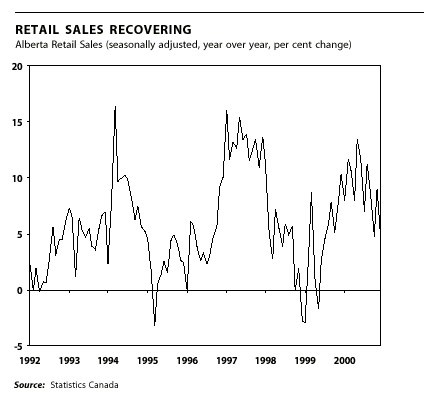
-
Retail sales in Alberta remain strong,
increasing 8.9% in 2000. Alberta leads the country in retail sales per
capita.
-
Strong growth in employment and wages and the
final installment of the tax plan are expected to maintain strong consumer
confidence and retail sales in 2001.
-
Retail sales are expected to grow by 8.1% in
2001 and by 4.4% per year on average over the medium-term.

diversification
strengthens alberta

-
Although the rebound in energy sector
investment dominated growth in 2000, Alberta’s economy is now more
diversified and less susceptible to volatile commodity price fluctuations
than it was in the 1970s and early 1980s. Energy accounted for only 20.7% of
Alberta’s GDP in 1999, compared to 37.2% in 1985.
-
Manufacturing increased its share of
Alberta GDP from 6.3% in 1985 to 11.1% in 1999 because of rapid growth in
electronic products, wood products, food processing, machinery and
transportation equipment, and chemicals.
-
The service sector grew from 53.9% of GDP
in 1985 to 65.9% in 1999 because of growth in business services (from 2.8%
in 1985 to 5.7% in 1999), finance, insurance and real estate (from 9.2% in
1985 to 12.6% in 1999) and wholesale trade (3.8% in 1985 to 5.6% in 1999).

PROVINCE
OF ALBERTA KEY energy and economic assumptionSa


sensitivities
to fiscal year assumption, 2001-02a


alberta
real gross domestic product forecast benchmark


oil
price forecast benchmark


natural
gas price forecast benchmark


canadian
short-term interest rate forecast benchmark


canadian
long-term interest rate forecast benchmark


canada/united
states exchange rate forecast benchmark


tracking
the forecasts of oil prices


tracking
the forecasts of alberta real gdp
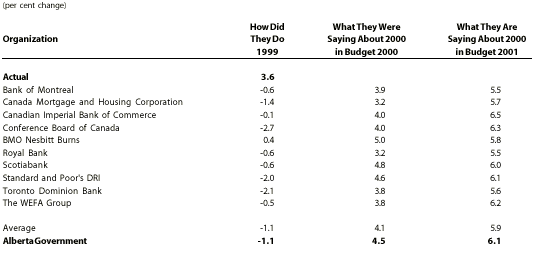

announced
major projects over $100 million
Proposed or Under Construction
|
Company Name |
Location |
Type
of Project |
Cost
($millions) |
Timing |
| Alberta
Energy Company |
Foster
Creek
|
Steam
Assisted Gravity Drainage (SAGD) Bitumen Project - Phase 1
|
320 |
2000-2002 |
| Albian
Sands Energy Inc. |
RM
of Wood Buffalo (Muskeg River)
|
Oilsands
Mining/Extraction Plant |
1,800 |
1999-2002 |
| Canadian
Natural Resources |
Cold
Lake/Pelican Lake Beartrap and Charlotte Lakes |
In
situ Bitumen Project |
800 |
1997-2002 |
| |
Primrose/Wolf
Lake |
In
situ Bitumen Project |
130 |
2001-2003 |
| Centurian
Gas Liquids Inc. |
Empress
to Fort Saskatchewan |
Straddle
Plant and Pipeline Project |
170 |
2000-2001 |
| Gulf
Canada Resources/ Fina Resources |
Surmont |
SAGD
Bitumen Project - Phase 2 |
280 |
2001-2004 |
| |
Surmont |
SAGD
Bitumen Project - Phase 3 |
280 |
2003-2010 |
| Imperial
Oil |
Cold
Lake |
Heavy
Oil Plant Expansion "Mahkeses" |
650 |
2001-2003 |
| |
Strathcona
County |
Strathcona
Refinery Upgrades |
500 |
2001-2005 |
| |
Sundre
area |
WestAlta
Straddle Plant |
250 |
2000-2001 |
| Japan
Canada Oil Sands |
Hangingstone |
SAGD
Bitumen Project - Phase 3 |
130 |
2000-2003 |
| Mobil
Oil Canada Cold Lake |
Cold
Lake |
In
situ Bitumen Project |
100 |
1997-2005 |
| OPTI
Canada Inc. |
RM
of Wood Buffalo(near Anzac) |
‘Long
Lake’ SAGD Heavy Oil Project |
450 |
2002-2004 |
| Pan
Canadian Resources |
Christina
Lake |
SAGD
Bitumen Project |
590 |
2000-2002 |
| Petro
Canada |
MacKay
River |
SAGD
Bitumen Project |
290 |
2000-2002 |
| |
Strathcona
County |
Gasoline
De-Sulphurization |
130 |
2001-2003 |
| Petrovera
Resources |
Lindbergh/Elk
Point/Frog Lake/Marwayne |
In
situ Bitumen Projects |
1,200 |
2000-2010 |
| Ranger
Oil Limited |
Lindbergh/Wolf
Lake/Elk Point/Cold Lake |
In
situ Bitumen Projects |
225 |
1996-2003 |
| Shell
Canada |
Strathcona
County |
Bitumen
Upgrader and Scotford Refinery Modifications |
2,100 |
2000-2002 |
| Suncor |
Fort
McMurray |
Production
Enhancement |
127 |
1999-2002 |
| |
Fort
McMurray |
Project
Millennium - Oilsands Plant Expansion |
2,800 |
1999-2001 |
| |
Primrose/Burnt
Lake |
In
situ Bitumen Facilities - Phase 2 |
100 |
2000-2001 |
| |
RM
of Wood Buffalo |
"Firebag"
In situ Bitumen Recovery Project |
750 |
2002-2005 |
| Syncrude
Canada |
Fort
McMurray |
Continuous
Improvement Program |
1,500 |
1997-2007 |
| |
Fort
McMurray |
Upgrader
Debottleneck II |
1,000 |
1998-2001 |
| Talisman
Energy |
Alberta
Foothills |
Exploration
and Development |
135 |
2001 |
| |
Peace
River |
Exploration
and Development |
125 |
2001 |
| PIPELINES |
|
|
|
|
| Cold
Lake Pipleine Limited Partnership |
Foster
Creek to Bonnyville area to Hardisty
|
Expansion
of Cold Lake Pipeline System |
143
|
2000-2002 |
| Corridor
Pipeline Ltd. (Trans Mountain Pipeline) |
Muskeg
River to Strathcona County
|
"Corridor"
Bitumen Pipeline |
700 |
2000-2003 |
| Enbridge
Pipelines Inc. |
Alberta
to Chicago |
Terrace
Expansion Pipeline Project |
650 |
1998-2002 |
| |
Fort
McMurray to Hardisty |
Wildrose
Pipeline - Phase 2 |
237 |
2000-2001 |
| Nova
Gas Transmission |
Throughout
Alberta |
Pipeline
Capacity Additions |
1,000 |
1999-2003 |
| Williams
Energy |
Strathcona
County |
Interconnecting
Pipelines |
235 |
2000-2001 |
| Petrochemicals |
|
|
|
|
| Shell
Canada |
Strathcona
County |
Hydrogen
Manufacturing Plant for Scotford Upgrader |
180 |
2000-2002 |
| Williams
Energy |
Sturgeon
City |
Hydrocarbon
Liquids Conservation Project |
220 |
2001-2002 |
| Forestry |
|
|
|
|
| Ainsworth
Lumber Company |
South
of Grande Prairie |
Mill
Expansion |
128 |
2001-2002 |
| Weyerhauser
Co. Ltd. |
County
of Grande Prairie |
Pulp
Mill Upgrades |
167 |
2001-2002 |
| COMMERCIAL,
RETAIL and REAL ESTATE CONSTRUCTION |
|
|
|
|
| Cameron
Corporation/ Grosvenor International Canada
Ltd. |
Edmonton |
Retail
Complex |
250 |
1997-2005 |
| East
Village Partnership Group |
Calgary |
Re-development
of East Village |
1,200 |
2001-2010 |
| ONTREA |
Calgary |
Chinook
Centre Expansion |
300 |
1997-2001 |
| Pauls
Properties Corp/GE Pension |
Calgary |
"Princeton"
Apartment Condominium Development |
125 |
2000-2004 |
| Stone
Creek Properties |
Canmore |
Silver
Tip Hotel/Resort Complex |
270 |
1995-2015 |
| Tsuu
T’ina Nation/PCL Construction Management |
MD
of Rocky View |
Casino/Housing/Shopping/Golf
Training Facility |
700 |
2001-2015 |
| OTHER |
|
|
|
|
| Alberta
Children’s Hospital Foundation/Calgary
RHA |
Calgary |
New
Children’s Hospital |
220 |
2001-2005 |
| Alberta
Transportation |
Alberta |
Highway
Twinning Project |
1,400 |
1998-2007 |
| |
Edmonton |
Anthony
Henday Drive Extension to Calgary Trail |
220 |
2000-2005 |
| Bell
Intrigna/Bell Nexxia/Axia Net Media & Partners |
Across Alberta
|
Fibre-optic
Communications Grid |
300 |
2001-2003 |
| Calgary
Airport Authority |
Calgary |
Airport
Improvements |
650 |
1998-2005 |
| Canadian
National Railways |
Edmonton
to Ontario |
Railway
Upgrade |
100 |
1997-2002 |
| City
of Calgary |
Calgary |
LRT
Extensions |
181 |
1999-2003 |
| |
Calgary |
Deerfoot
Trail Extension |
134 |
2000-2002 |
| City
of Edmonton |
Edmonton |
LRT
Extension to Jubilee Auditorium |
109 |
2002-2004 |
| Edmonton
Regional Airport Authority
|
Leduc
County |
International
Airport Terminal Modifications |
265 |
1998-2002 |
| Mount
Royal College |
Calgary |
Campus
Development Phases I and 2 |
150 |
2000-2005 |
| University
of Calgary |
Calgary |
Health
Research Innovation Centre |
110 |
2001-2003 |
| Various
Irrigation Districts |
Southern
Alberta |
Irrigation
Systems |
600 |
1997-2006 |
| POWER
PLANTS* |
|
|
|
|
| AES
Calgary Inc. |
MD
of Rocky View (east of Calgary) |
Natural
gas fired Power Station (525 MW) |
450 |
2001-2003 |
| Atco
Power |
Near
Fort McMurray |
Cogeneration
Power Plant (172 MW) |
200 |
2001-2003 |
| Atco
Power/Shell Canada/ Air Products Canada |
Strathcona
County |
Cogeneration
Power Plant (150 MW) |
140 |
2000-2002 |
| EPCOR |
Parkland
County |
Genessee
Power Plant Expansion (400 MW) |
500 |
2002-2004 |
| Nexen/Pan
Canadian Petroleum |
MD
of Rocky View |
Natural
Gas Fired Cogeneration Plant |
100 |
2001 |
| Pan
Canadian Petroleum Ltd. |
Wheatland
County (SE of Strathmore) |
Natural
Gas Fired Cogeneration Plant (106 MW)
|
100 |
2001 |
| TransAlta
Utilities |
Parkland
County |
Expansion
of Keephills Coal-fired Cogeneration
Plant (900 MW) |
1,800 |
2002-2005 |
| |
Parkland
County |
Efficiency
Update at Sunshine Thermal Plant (218 MW) |
200 |
2001-2003 |
| TOTAL |
|
|
31,366 |
|
* Note that this excludes projects
already included in oil sands developments (808 MW) and other major projects
(920 MW) which are being proposed, but which are not yet officially announced.

Go to: The
Alberta Advantage
|
